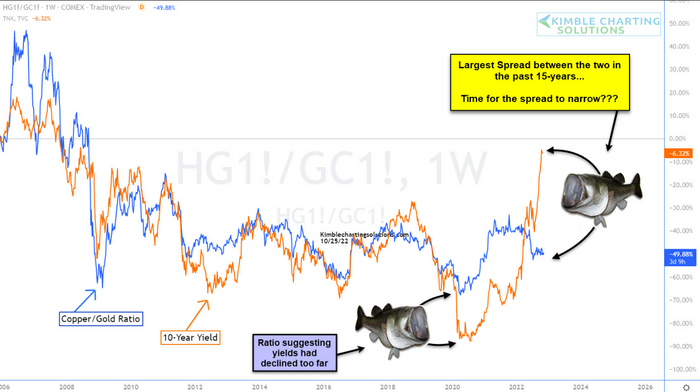The copper-to-gold ratio and U.S. Treasury yields have usually followed each other throughout recent history, but the widening spread between the two shows the recent rally in 10-year yields could be overdone, said Chris Kimble of the Kimble Charting Solutions.
Kimble used this chart of a 20-year correlation between the copper-to-gold ratio and the 10-year treasury yield
TMUBMUSD10Y,
to explain why. He has followed this correlation to see if bond yields are changing trend, or if the trend has become overdone.

SOURCE: KIMBLE CHARTING SOLUTIONS
“As you can see, the two tend to follow each other in trend. The spread between the two is its widest in a couple of decades right now, with the 10-year bond surging higher,” the chart watcher wrote in a Wednesday note.
It seems likely that it is time for the spread to narrow, or it would suggest “some credit-quality issues in the U.S. government-bond paper,” which would be a whole other concern, Kimble said.
“This trend is on our radar as inflation is a major nemesis and the Federal Reserve is raising interest rates very quickly,” Kimble wrote. “This has spurred a fast rally in 10-year yields.”
Read: Recession ahead? This bond-market indicator is flashing a ‘code orange’ warning.
The yield on the 10-year Treasury slipped to 3.938% on Thursday as investors reassessed the Federal Reserve’s path after the Bank of Canada delivered a smaller-than-expected rate hike the day before. On Thursday, the European Central Bank announced a widely expected interest-rate increase of 75 basis points, to 1.5%. The hike was interpreted by investors to be a dovish move in the bank’s rate outlook.
For the month, the 10-year yield is up 0.136 percentage points, while year to date the yield is up 2.442 percentage points, according to Dow Jones Market Data.
Fed-funds futures traders now see a 87.3% probability of a 75-basis-point hike at the Fed’s policy meeting next week, according to the CME FedWatch tool. But the probability of a 75-basis-point rise in December fell to 37.7% on Thursday, while the probability of a 50-basis-point rise increased to 55%.
See: Market expectations start to shift in direction of slower pace of rate hikes by Fed
“The ‘copper-to-gold’ ratio indicates U.S. rates are too high as industrial growth relative to gold has not kept up,” said Jim Masturzo, chief investment officer at Research Affiliates. “This metric provides a nice indicator on the needed direction of rates, but timing is difficult to discern.”
Gold for December delivery
GC00,
GCZ22,
was down $3.60, or 0.2%, to settle at $1,665.60 an ounce on Comex on Thursday. December copper
HGZ22,
fell 0.7% to $3.5195 an ounce.
